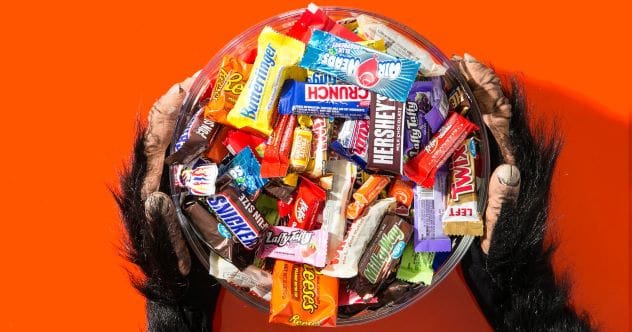In late September, Candystore.com compared Halloween candy sales to find the most popular treats. The top 10 might not surprise you, but the state-by-state breakdown reveals some interesting favorites. For example, Ohio loves Blow Pops, Montana prefers Dubble Bubble Gum, Georgia goes for Swedish Fish, and Louisiana enjoys Lemonheads. However, none of these candies made the national top 10.
So, let’s unwrap the top Halloween candies in America and explore their sweet—and sometimes not-so-sweet—origins!
10. Candy Corn
Scratching your head about candy corn making the top 10? You’re not alone! But the numbers don’t lie. The National Confectioners Association (NCA) reports that 35 million pounds of candy corn are sold each Halloween. That’s nine billion kernels! If laid end-to-end, they’d circle the Earth more than four times.
This candy is definitely polarizing. People either love it or hate it, with more leaning toward the latter. Its enduring appeal might be its age. For many (52%), candy corn is a tradition. Halloween just wouldn’t be the same without a bowl of it sitting out, maybe with peanuts mixed in. Of course, a lot of that bowl usually ends up in the trash after Thanksgiving.
Back in the late 1800s, many candies called buttercreams were molded into agricultural or nature-inspired shapes, like clover or chestnuts. In a heavily agrarian country, these appealed to farmers and their families. Candy corn, also agrarian-inspired, stood out due to its bright colors.
George Renninger, who spent 68 years at Philip Wunderle Candy Company, is often credited with inventing candy corn around the 1880s. His recipe involved melting corn syrup, fondant, vanilla, sugar, and marshmallow crème into a slurry. This was then divided, colored yellow, orange, and white, and poured into triangular molds one color at a time. Cooling in the mold melded the colors in layers. Although now automated, the basic process remains largely unchanged.
There’s even a debate about the right way to eat candy corn. The NCA found that 47% eat it whole, while 43% eat it layer-by-layer, starting with the white tip. Only a tenth begin with the wider yellow end. [1]
9. Tootsie Pops
A long-standing mystery surrounds Tootsie Pops. It’s not just about how many licks it takes to reach the Tootsie Roll center, but we’ll get to that. The real mystery is why a Native American has appeared on some wrappers since the candy’s creation in 1931. The figure wears a traditional headdress and aims a bow and arrow at a star.
According to Snopes.com, only about 30% of Tootsie Pops have this icon. This rarity has fueled a rumor that these “special” wrappers can be redeemed for a prize. While some candy companies in the 1930s had promotions offering prizes for wrappers, Tootsie Roll Industries (TRI) has never been one of them.
TRI claims they still receive about 150 letters with these wrappers from kids hoping for a prize. Since 1982, they’ve sent a consolation letter with a story about a Native American appearing to the Tootsie Pop creator, offering the secret to a new lollipop shape. The Native American shoots an arrow at a star, inspiring the inventor to create a round lollipop based on the moon. While charming, the story is unsatisfying if you expected a prize. The company’s other explanation, that the star symbolizes luck, doesn’t explain the Native American figure. A better answer is the mystery itself – it generates publicity.
TRI has a history of using mystery to sell Tootsie Pops. In 1970, a cartoon owl famously asked, “How many licks does it take to reach the Tootsie Roll center of a Tootsie Pop?” Fifty years later, there’s still no definitive answer, despite numerous attempts.
Engineers at Purdue University built a licking machine that mimicked a human tongue and found it took an average of 364 licks. Not to be outdone, an engineering student at the University of Michigan built his own machine and came up with 411 licks. Other studies range from 144 to 2,500 licks. The commercial’s narrator was right: we may never know. [2]
8. Snickers
Franklin C. Mars, the creator of Snickers, had polio as a child and learned to make candy in his mother’s kitchen. At 21, Frank supported his wife, Ethel, and son, Forrest, by selling candies wholesale. However, the market was oversaturated, and Frank’s venture failed. Ethel divorced him in 1910, sending 8-year-old Forrest to live with her parents in Canada. Frank rarely saw his son in the following years.
Attempting a fresh start, Frank remarried another Ethel and moved to Tacoma, Washington, where he tried manufacturing candy. When that failed, they returned to Minneapolis, where Frank started a basket candies business featuring Patricia Chocolates, named after their daughter. Two years later, the business incorporated and produced the Mar-O-Bar.
In 1923, Forrest, then a traveling salesman for Camel cigarettes, was arrested in Chicago for illegal cigarette ads. Frank bailed him out, and the two went to a soda shop. While drinking a chocolate malt, Forrest asked why his father hadn’t made a chocolate-malted candy bar. Thus, the Milky Way was born. Within a year, Frank’s company’s revenue jumped tenfold to $800,000 (about $11 million today), and by 1928, their gross was $20 million ($273 million today).
Frank and Ethel indulged in their newfound wealth, purchasing a 3,000-acre farm in Tennessee for Ethel to breed horses, named Milky Way Farm. After three years of experimenting, Frank introduced Snickers in 1930, named after Ethel’s favorite horse. Today, Snickers often tops the list of most popular candy bars in both America and the world. However, in 2020, it fell behind Hershey bars in sales ($394 million versus $381 million). That still translates to 15 million Snickers bars made every day. [3]
7. Hershey Kisses
While many believe Milton Hershey invented these chocolate teardrops, his version was a copy of Wilbur Buds, released by Henry Oscar Wilbur in 1894. Wilbur Buds were made by pouring melted chocolate into tear-shaped molds and letting them solidify, each with “Wilbur” imprinted on the bottom.
Hershey, already automating production of Hershey Bars (released in 1900), found that the teardrop shape could be achieved by simply squirting chocolate onto a flat surface. Soon after its introduction in 1907, Hershey’s confection outsold Wilbur’s. Wilbur sued Hershey to stop production but was unsuccessful. Wilbur Buds are still available online.
For the first 14 years, Kisses were hand-wrapped in silver foil. In 1921, the process became automated, adding the tissue paper tag. In 1962, Hershey’s Kisses were among the first candies to change their packaging (red and green) for Christmas. The origin of the name “Kisses” is uncertain, but similar candies packaged in paper with a twist had been called “kisses” since the 1820s. The 1856 Webster’s Dictionary defines a kiss as “a small piece of confectionary.” Hershey trademarked “Kisses” in 2001 after surveying the public and finding most people associated the word with their product. [4]
6. Sour Patch Kids
If you can get past eating a kid-shaped candy, Sour Patch Kids (SPK) reward you with a sour then sweet taste. The gummy is coated with tartaric and citric acid. These acids activate protons in saliva, which the tongue registers as a strong sour taste. Once the coating dissolves, only the sweet gummy remains. However, the coating makes it a target for tampering. In 2015, Florida drug dealers rolled gummies in Flakka—a synthetic drug that causes hallucinations—to mimic SPK.
Created in the early 1970s by Frank Galatolie for Jaret International of Ontario, Canada, SPK was originally named Mars Men and shaped like Martians. In 1985, when the candy was introduced in the U.S., it was renamed Sour Patch Kids to capitalize on the Cabbage Patch Kids craze. The shapes were altered to be more kid-like, and the new packaging featured a blonde boy with his tongue hanging out, based on Galatolie’s son, Scott.
SPK is not the only candy to come in a cereal, but it may be the only one that makes the milk taste sour. It’s not the only candy to flavor ice cream or appear in a video game either. But it may be the only candy added to beer. Mob Craft Beer introduced Sour Catch, a Belgian pale ale flavored with SPK. [5]
5. Hot Tamales
Hot, spicy candy isn’t for everyone, but spicy-lovers are very loyal to certain candies, including Hot Tamales. Introduced in 1950 by Just Born, Inc., Hot Tamales is a cinnamon-flavored candy that became a movie theater staple. It has been around for over 80 years but isn’t the first cinnamon-based candy. Cinnamon contains cinnamaldehyde, a skin irritant that the tongue registers as hot. Cinnamon is mentioned in the Bible, in Egyptian hieroglyphics, and in Sanskrit writings. Cinnamon flavoring found its way into candy and medicine in the 19th century, and Red Hots, introduced 18 years before Hot Tamales, are still its main competitor.
Recently, the trend is to make candy hotter, even painfully so, hot enough to register on the Scoville Hotness Scale. This scale measures capsaicin—another chemical irritant—in food, typically peppers. A bell pepper has a zero Scoville Heat Unit (SHU), a jalapeno pepper is between 2,500 and 8,000 SHUs, and a U.S. Grade pepper spray reaches up to 5.3 million SHUs. Hot Tamales do not have capsaicin, so the Scoville Scale can’t measure them, but one blogger equates Hot Tamales’ heat to a Poblano Pepper, about 1,000 to 1,500 SHUs.
The same blogger said the more recent Hot Tamales Fire was equivalent to a Seranno pepper, or 10,000 to 23,000 SHUs. Atomic Fireballs, introduced in 1954, have capsaicin and register 3,500 SHUs. The candy touted as the hottest is the Toe of Satan lollipop, with cinnamon and chile extract measured at nine million SHUs. [6]
4. Starburst
In November 1938, Marcus Pfeffer, a Jewish physician in Vienna, Austria, was warned about an impending pogrom, where Hitler’s SA would attack synagogues and Jewish property. Kristallnacht (“Crystal Night”) saw hundreds of synagogues and thousands of businesses burned, and tens of thousands of men arrested and sent to concentration camps.
Jewish homes, including Pfeffer’s, were ransacked. Marcus contacted a relative in England to act as guarantor for his family. He packed up his wife Betty and three-year-old son Peter and fled hours before his scheduled arrest. The family waited in Zurich, Switzerland, before boarding a plane to London. They were living in London when Germany bombed the city, destroying their apartment. The Pfeffers decided to stay in Bansbury.
After the war, Peter grew up to be a journalist, eventually moving into advertising. In 1959, Mars, Inc. in England developed soft, fruit-flavored taffy squares and held a contest to name them. Peter, having changed his name to Phillips, worked as an ad copywriter and won the contest.
His winning name, Opal Fruits, earned him five pounds. It lasted nearly 30 years in Europe, but when Mars brought the candy to America, they called it M&M’s Fruit Chewies, then Starburst a few years later. In 1998, Europe adopted the name Starburst, although Opal Fruits occasionally makes a comeback. [7]
3. M&M’s
We’ve already discussed Frank and Forrest Mars. After Forrest’s Milky Way idea, Frank groomed him to take over Mars Company. However, after a fight in 1932, Frank removed Forrest from Mars, Inc., giving him $50,000 and foreign rights to Milky Way. Forrest went to Switzerland to learn chocolate-making and traveled Europe working for chocolate companies. Back home, Frank died of heart problems in 1934, and his wife Ethel took over Mars, Inc.
Forrest moved to York, England, to work for H.I. Rowntree and Company and helped introduce their Kit Kat bars. He also opened his own factory in Slough, England, producing a sweeter version of the Milky Way called the Mars Bar. At Rowntree, in 1937, the company began making small chocolate beads in a hard shell called Smarties (different from the tart Smarties today) for British soldiers in the Spanish Civil War. The hard shell prevented melting. Forrest realized the potential of these portable candies during warm months.
Forrest returned to America and patented his idea in March 1941. He didn’t turn to his stepmother or Mars Company but formed his own company instead. World War II broke out, and Hershey’s Co. controlled all rationed chocolate. Forrest invited Bruce Murrie, son of Hershey’s president William Murrie, to start the Mars & Murrie Company, M&M for short, using Hershey’s chocolate. Initially, M&M’s were offered exclusively to the U.S. Armed Forces. Vets brought word of the candy home, expanding its market. Today, Mars still donates M&M’s to America’s MRE program.
After the war, Bruce Murrie noted that Forrest Mars was difficult to work with. Known for his temper, Forrest would throw candy at a window if it was mis-wrapped. He would humiliate Murrie in front of employees, so Murrie sold his 20% share for $1 million. When Murrie tried to return to Hershey’s, he was rejected due to his partnership with a competitor.
Forrest tried to gain control of his father’s company, but it wasn’t until his stepmother died in 1945, giving Forrest 50% of her stock, that he returned to Mars, Inc. He brought M&Ms and his Mars Bar (the American version has almonds). [8]
2. Skittles
Skittles are shaped like M&M’s and even sport a letter (S) just like its chocolate cousin. It’s produced by the William Wrigley Jr. Company, a subsidiary of Mars, Inc. But in taste, they couldn’t be more different. Even when they share flavors—like the Chocolate Mix Skittles in 2007 and the Key Lime Pie M&M’s—they retain their unique flavors.
The inventor of Skittles is unknown, but an uncredited British company first produced them in 1974. A story circulates about “Mr. Skittles” seeing a rainbow and wondering what it would taste like, then experimenting for three years to create a rainbow-flavored candy.
This story originates from the 1994 “Taste the Rainbow” campaign. The name Skittles likely comes from the European lawn or pub bowling game. The balls are heavy, round, smaller than a bowling ball, and often colored differently. Americans first tasted the rainbow in 1979. [9]
1. Reese’s Peanut Butter Cups
The origins of Reese’s Peanut Butter Cups come from the fertility of its creator, Harry Burnett (H.B.) Reese. H.B. and his wife, Blanche Edna Hyson, had 16 children—eight boys and eight girls—13 of whom lived to adulthood. For the first two decades of their marriage, H.B searched for a fulfilling job while supporting his large family.
He found working at farms, fisheries, and factories unsatisfying but still worked multiple jobs to make ends meet, though ends rarely met. While working at a Hershey Chocolate Company dairy farm, he noticed the lucrativeness of the candy-making business. “If Hershey can sell a trainload of chocolate every day, I can at least make a living making candy,” he said.
In 1921, Blanche’s father bought a larger home for the Reese family in Hershey, Pennsylvania, and H.B. began working at the Hershey factory. He also made and sold confections from his basement, starting with mints, hard candies, and chocolate-covered raisins and nuts sold directly to stores. H.B. invented a chocolate-covered caramel and coconut candy he dubbed the “Lizzie Bar” after his oldest daughter, Mary Elizabeth. She remembered her father heading to the basement at 3 am to crack open, peel, and grate coconuts. Her brother Johnny also had a candy bar named after him.
By 1926, H.B.’s candies earned enough for him to quit his job at Hershey’s and move the operation to a factory. In 1928, H.B. developed peanut butter cups as part of an assorted candy package, including coconut, peppermint cream, chocolate jets, nougat, nuttees, and peanuts and raisin clusters. Mary Elizabeth helped hand-coat the Hershey chocolate over the centers on marble slabs before letting the chocolate set in paper cups. H.B. would often set up coating tables in store windows to entice passersby to taste their confections.
By 1935, the peanut butter cup became so popular it was sold separately, and by World War II, rationing forced H.B. to produce only Reese’s Peanut Butter Cups. After H.B. died suddenly of a heart attack in 1956, his sons sold the company to Hershey Company in 1963 for 5% of its stock, worth roughly $23.5 million. Today, that stock is worth $1 billion, partly because Reese’s tops many lists as the most favored Halloween candy. [10]
From the sweet tradition of Candy Corn to the iconic Reese’s Peanut Butter Cups, each of these popular Halloween candies has a unique story. Whether it’s about overcoming adversity, accidental inventions, or just plain deliciousness, these treats have earned their place in our Halloween celebrations.
What’s your favorite Halloween candy? Leave your comment below!










